Analysis of liquid products and mechanism of thermal/catalytic pyrolysis of polypropylene
IF 6.3
2区 化学
Q1 POLYMER SCIENCE
引用次数: 0
Abstract
Rapid thermal and catalytic pyrolysis of polypropylene (PP) were carried out using Py-GC/MS. The distribution of products of rapid pyrolysis and the influence of FCC catalyst on pyrolysate production were studied both qualitatively and quantitatively at the temperature of 500 °C. The corresponding reaction pathways were suggested based on the experimental results. The results showed that the olefin content of PP cracking products exceeded 99 wt. %, which were monoolefines with carbon number of 3n and diolefins with carbon number of 3n+1, respectively, and only a very small amount of alkanes. The catalyst promoted the formation of monolefine and decreased the content of diolefin. With the addition of catalyst, the content of small molecular weight monolefine between C9 and C21 increased by 13.6 wt. %, while the diolefin content of C15+ decreased to varying degrees. The thermal and catalytic pyrolysis of PP can be reasonably explained using free radical mechanism and carbonium ion mechanism, respectively.
聚丙烯热/催化热解液产物及机理分析
采用Py-GC/MS对聚丙烯(PP)进行了快速热裂解和催化热解。在500℃的温度下,对快速热解产物的分布及FCC催化剂对热解产物产量的影响进行了定性和定量研究。根据实验结果,提出了相应的反应途径。结果表明,聚丙烯裂解产物的烯烃含量超过99%,主要为碳数为3n的单烯烃和碳数为3n+1的二烯烃,烷烃含量极低。催化剂促进了单烯烃的生成,降低了二烯烃的含量。随着催化剂的加入,C9 ~ C21之间的小分子量单烯烃含量增加了13.6 wt. %,而C15+的二烯烃含量则有不同程度的下降。PP的热热解和催化热解可以分别用自由基机理和碳离子机理来合理解释。
本文章由计算机程序翻译,如有差异,请以英文原文为准。
求助全文
约1分钟内获得全文
求助全文
来源期刊

Polymer Degradation and Stability
化学-高分子科学
CiteScore
10.10
自引率
10.20%
发文量
325
审稿时长
23 days
期刊介绍:
Polymer Degradation and Stability deals with the degradation reactions and their control which are a major preoccupation of practitioners of the many and diverse aspects of modern polymer technology.
Deteriorative reactions occur during processing, when polymers are subjected to heat, oxygen and mechanical stress, and during the useful life of the materials when oxygen and sunlight are the most important degradative agencies. In more specialised applications, degradation may be induced by high energy radiation, ozone, atmospheric pollutants, mechanical stress, biological action, hydrolysis and many other influences. The mechanisms of these reactions and stabilisation processes must be understood if the technology and application of polymers are to continue to advance. The reporting of investigations of this kind is therefore a major function of this journal.
However there are also new developments in polymer technology in which degradation processes find positive applications. For example, photodegradable plastics are now available, the recycling of polymeric products will become increasingly important, degradation and combustion studies are involved in the definition of the fire hazards which are associated with polymeric materials and the microelectronics industry is vitally dependent upon polymer degradation in the manufacture of its circuitry. Polymer properties may also be improved by processes like curing and grafting, the chemistry of which can be closely related to that which causes physical deterioration in other circumstances.
 求助内容:
求助内容: 应助结果提醒方式:
应助结果提醒方式:


